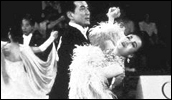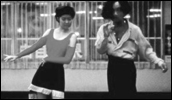Shall We Dance?
- Year
- 1996
- Original title
- Shall We Dansu?
- Japanese title
- Shall we ダンス?
- Director
- Cast
- Running time
- 136 minutes
- Published
- 20 March 2001



by Jasper Sharp
Despite the country's long cinematic history, commercially successful releases from Japan are pretty rare on this side of the world. Put simply, Japanese culture seems far too alien and too damn odd to resonate much with Western mainstream audiences, which is what makes the universal appeal of Shall We Dance? all the more fascinating.
Initially released in its home country in 1996, it picked up an impressive 13 Japanese Academy Awards. Whilst on its US release, where it was distributed by Miramax, it pretty much cleaned up to become one of the highest-grossing foreign language titles of all time (though through a loophole in the rules, was deprived of a Best Foreign Language Academy Award nomination in 1997 because it had already been shown on television in Japan the previous year).
Koji Yakusho, star of Shohei Imamura's quirky The Eel, plays Sugiyama, a man with whom a lot of people will empathise. Married with a teenage daughter, mortgaged up to his eyeballs, and financially trapped in an insipid career in accountancy outside of which he has no interests, Sugiyama represents the ultimate time-serving, clock-watching employee. He seeks romantic escapism in the image of the beautiful Mai (Tamiyo Kusakari), seen one evening from his train home gazing out of the window of a nearby dance school. Against his better judgement and without telling a soul, he enrolls at the dance school and is drawn into the secret world of dance socials and private lessons.
After his romantic advances are firmly rebuffed by Mai, he overcomes his initial awkwardness on the dance floor and along with the others in his beginner's class, soon finds himself loving dance as an end to itself. Meanwhile Sugiyama's wife, suspicious of his recent exuberance and the lingering scent of perfume on his shirts, hires a private detective to find out what exactly is going on.
Miramax's release of Shall We Dance? (edited from 136 minutes to 118) was such a success upon its US release that the company immediately picked up the remake rights. Though the original package, with Tom Hanks slated to star and John Turteltaub (guiding hand behind such mawkish pieces as Cool Runnings, Phenomenon and Instinct) to direct, was never actually green-lighted, the company's subsequent attempts at making the film available to the wider home viewing market have been pretty much non-existent, unjustly burying the film in the mists of time in the West. Fortunately a full-length subtitled copy was released in Hong Kong, so that the curious could at least see what the fuss was about. (The remake, of course, later did emerge with Richard Gere and Jennifer Lopez in the leads.)
There were also a few differences in the subtitlings of the two versions, most notably the voice-over at the beginning of this shorter US release which takes pains to inform us that in Japan, where married couples rarely say I love you or hold hands in public, the idea of dancing together in public is "beyond embarrassing". The full-length Japanese version obviously doesn't have to bother explaining Japanese culture to its native audience, instead giving a historical background to the evolution of ballroom dancing in Europe.
It is this cultural perspective that gives the film its dramatic resonance. All of the men enrolled on the dance course are there for reasons that they'd rather not have to explain. "Yeah, they all say that!" counters one character when Sugiyama explains that he took up ballroom dancing after he heard it was a good form of exercise. "People will think I'm only here for the girls", says another. It is the way in which Sugiyama and his fellow dancers find a mutual bond in their secret lives that is so heartwarming. These are self-conscious men who have willingly thrown themselves into a world where women predominate, overcoming their initial inhibitions to guiltily indulge in their harmless pleasures to the full.
In this way Sugiyama forms a clandestine friendship with Aoki, the systems analyst at the company where he works. By day the butt of office ridicule, at night transformed Flashdance-style into a testosterone-dripping King of the Rumba, Naoto Takenaka almost completely steals the show in one of the finest comic turns of the past few years.
Despite a few plodding moments, most apparent in an unnecessarily long-winded denouement in which the various threads of the story are rather hamfistedly tied up, the film is a delight from start to finish. The characters achieve a degree of buoyant absurdity that is quite endearing and the fact that they are so deeply expressed in terms of their physicality rather than by language is what gives Shall We Dance? its cross-cultural appeal. Suo's film, particularly in the colourfully vivacious dance sequences, is packed full with visual detail, taking in each of the characters and their individual dancing styles. From his first awkward steps onto the dance floor, Sugiyama's emotional journey from respected but unfulfilled office drudge to an assured and valued member of the dance school is uplifting in the extreme. Perhaps the most exhilarating aspect to the whole thing is that all of the characters look as if they're enjoying themselves so much.
Writer/director Masayuki Suo, whose previous film Sumo Do, Sumo Don't also picked up a Japanese Academy Award for Best Film in 1992, has focused on making a film for an audience which remains largely uncatered for - the middle-aged professional. As a result Shall We Dance? is far warmer than most of the Japanese films showcased abroad, and its simple-minded escapism is hard to resist. It is colourful and buoyant, moving and inspiring, and still, a few years after the initial critical clamouring has subsided, just as strong as ever.